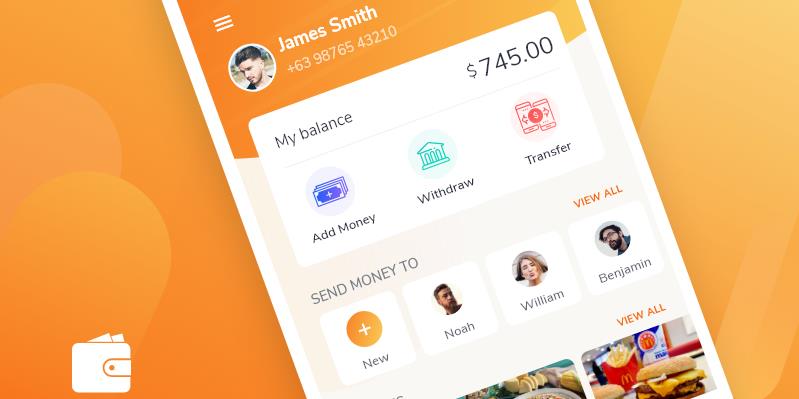3 Step Guide to Build a Secure Mobile Wallet App in 2020
The Internet has brought the entire world a platform for many purposes. With the boom of growing cross-border businesses, digital payments are an immense hit.
According to the research, the revenue of the global mobile payment market has increased from $450 billion to $780 billion, and it is estimated to grow up more than $1 trillion in next year.
With such promising figures, investing in mobile wallet app can turn out to be a smart move for your business. Here’s a clear guide for you on creating a secure mobile wallet app that helps you to conquer the market and stay competitive in 2020.
Step 1: Select mobile wallet app Features
In this highly competitive industry, you need to provide high-end and secure features to your users. The following features are the essential features for any mobile wallet app.
- Accept different forms of payment: Your app should allow different modes of payments including debit card, credit card, UPIs, cryptocurrencies, Net banking and others.
- Compatible with all operating systems: The app should be compatible with all major operating systems including Android, iOS, Windows and others.
- Rewards and loyalty: There should be a reward program feature in the wallet. Whenever the user pays or receives money, he should also earn rewards or loyalty points.
- Intuitive User interface: The user interface should be simple, and the user can easily access everything from a single dashboard.
- Security: Security should be the top-notch priority while building the mobile app. The user’s data can be encrypted and secured with a secured server.
Step 2: Identify the mobile wallet app development Challenges
The mobile payment solutions are emerging as a new way of banking and conducting financial transactions. The future is full of challenges as you have to face many hurdles for the continuity of the app. Below are the problems that mobile wallets are going to face shortly.
- Low connectivity: If you are targeting developing countries of Africa and Asia, then low connectivity is one of the biggest hindrances. Majority of the population is living in remote areas with low connectivity and weak signals which affects the usability and scalability of your mobile wallet app.
- Low technical know-how: This problem persists even in the developed countries where the vast number of users doesn’t have any technical knowledge.
- Low adoption rate: With smartphones ruling our lives, most of the people are not confident about sharing their banking credentials online. They are still afraid of hackers and data breach. Thus, it affects the adoption rate, and people tend to choose old-school methods of making payments through cash and cheque.
Step 3: Technologies used for developing a mobile wallet app
You know how to use a mobile wallet. You open the app, link your bank account or credit card using a pin or password, secure the app with a fingerprint scanner and start making payments. You can collect rewards and apply coupons against the transaction.
For this entire process, the mobile payment app uses several technologies. Below are the most current techniques that are used to build the mobile wallet app. You need to consult with your mobile wallet app development company for the most suitable technology that sustains the future of mobile payments.
Near-field communication
It is one of the contactless and remote technology which facilitates payments up to the distance of 10 cm. It works almost like the Bluetooth, but it is allied immediately whereas Bluetooth takes one-tenth of a second. It is a versatile technology and functions even if the compatible device does not have power.
QR codes
Paytm is an excellent example of QR codes. The user needs to scan the QR codes to initiate the payment. There are QR code generators with the help of which you can encrypt the information, create a code, and add the image of generated QR code on forms of the receipts.
iBeacon
It enables radio beacons to initiate contactless data exchange with little power consumption. The device emits a signal in an uninterrupted manner received by the smartphone with BLE. The user needs to activate the Bluetooth to get the radio beacons.
Cloud-based app
You can even build mobile wallet app based on cloud technology. It is convenient and easy to use PayPal is the perfect example of a mobile wallet app using the cloud for storing information and exchanging data for initiating payments. The users need to enter their mobile number and pin code to complete the transaction at any Point of sale.
Hire the best mobile wallet app development company
Make sure you build a mobile wallet app as per the convenience of your users. It should target ordinary people with least technical know-how. The users prefer a simple platform to access their services. They don’t have any time to understand your app from scratch. The mobile wallet app should be lighter, with just essential features and fully optimized. You can ask your mobile wallet app development company to focus on app performance and app scalability.
Related Posts
Some people tend to use cryptocurrencies as a means of payment. Indeed, digital assets are accepted as a payment method in some shops and restaurants.
Cryptocurrencies offer many advantages. They are easy for paying for goods and services, sending funds abroad without fees, and you can even earn money on the cryptocurrency market.
Bitcoin investment is the largest in the crypto sector today.
There has been a major technological revolution in recent years, and now almost all of our sectors are driven by computers and technology.
In the world of software development and delivery, containers have become an increasingly popular way to package and deploy code.
Nowadays, as the logistics industry is evolving rapidly, technological support is crucial for its growth.


















Comments
comments powered by Disqus